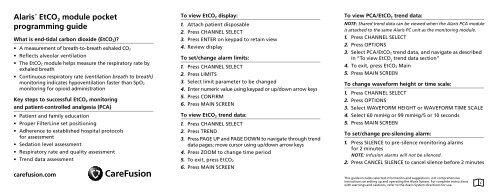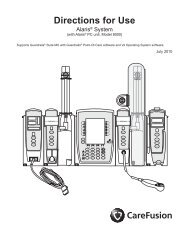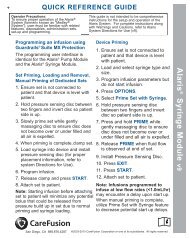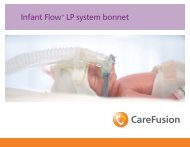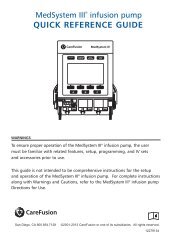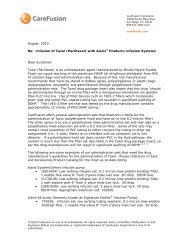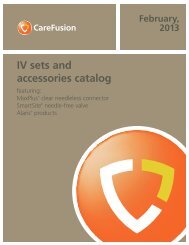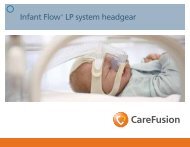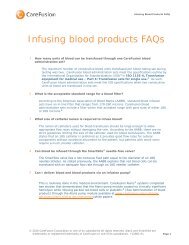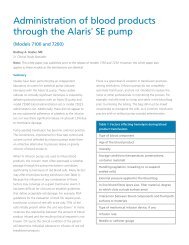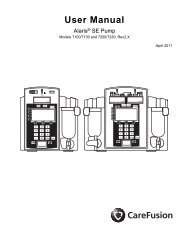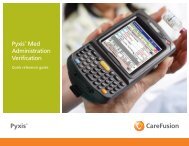Alaris® EtCO2 module pocket programming guide - CareFusion
Alaris® EtCO2 module pocket programming guide - CareFusion
Alaris® EtCO2 module pocket programming guide - CareFusion
Create successful ePaper yourself
Turn your PDF publications into a flip-book with our unique Google optimized e-Paper software.
Alaris ®<br />
<strong>EtCO2</strong> <strong>module</strong> <strong>pocket</strong><br />
<strong>programming</strong> <strong>guide</strong><br />
What is end-tidal carbon dioxide (<strong>EtCO2</strong>)?<br />
• A measurement of breath-to-breath exhaled CO2<br />
• Reflects alveolar ventilation<br />
• The <strong>EtCO2</strong> <strong>module</strong> helps measure the respiratory rate by<br />
exhaled breath<br />
• Continuous respiratory rate (ventilation breath to breath)<br />
monitoring indicates hypoventilation faster than SpO2<br />
monitoring for opioid administration<br />
Key steps to successful EtCO 2 monitoring<br />
and patient-controlled analgesia (PCA)<br />
• Patient and family education<br />
• Proper FilterLine set positioning<br />
• Adherence to established hospital protocols<br />
for assessment<br />
• Sedation level assessment<br />
• Respiratory rate and quality assessment<br />
• Trend data assessment<br />
carefusion.com<br />
To view EtCO 2 display:<br />
1. Attach patient disposable<br />
2. Press CHANNEL SELECT<br />
3. Press ENTER on keypad to retain view<br />
4. Review display<br />
To set/change alarm limits:<br />
1. Press CHANNEL SELECT<br />
2. Press LIMITS<br />
3. Select limit parameter to be changed<br />
4. Enter numeric value using keypad or up/down arrow keys<br />
5. Press CONFIRM<br />
6. Press MAIN SCREEN<br />
To view EtCO 2 trend data:<br />
1. Press CHANNEL SELECT<br />
2. Press TREND<br />
3. Press PAGE UP and PAGE DOWN to navigate through trend<br />
data pages; move cursor using up/down arrow keys<br />
4. Press ZOOM to change time period<br />
5. To exit, press <strong>EtCO2</strong><br />
6. Press MAIN SCREEN<br />
To view PCA/<strong>EtCO2</strong> trend data:<br />
NOTE: Shared trend data can be viewed when the Alaris PCA <strong>module</strong><br />
is attached to the same Alaris PC unit as the monitoring <strong>module</strong>.<br />
1. Press CHANNEL SELECT<br />
2. Press OPTIONS<br />
3. Select PCA/<strong>EtCO2</strong> trend data, and navigate as described<br />
in “To view EtCO trend data section”<br />
2<br />
4. To exit, press <strong>EtCO2</strong> Main<br />
5. Press MAIN SCREEN<br />
To change waveform height or time scale:<br />
1. Press CHANNEL SELECT<br />
2. Press OPTIONS<br />
3. Select WAVEFORM HEIGHT or WAVEFORM TIME SCALE<br />
4. Select 60 mmHg or 99 mmHg/5 or 10 seconds<br />
5. Press MAIN SCREEN<br />
To set/change pre-silencing alarm:<br />
1. Press SILENCE to pre-silence monitoring alarms<br />
for 2 minutes<br />
NOTE: Infusion alarms will not be silenced.<br />
2. Press CANCEL SILENCE to cancel silence before 2 minutes<br />
This <strong>guide</strong> includes selected information and suggestions, not comprehensive<br />
instructions on setting up and operating the Alaris System. For complete instructions<br />
with warnings and cautions, refer to the Alaris System directions for use.
The associated possible responses are suggestions only and not meant to replace<br />
current clinical practice or hospital protocols. Always consult hospital protocols.<br />
Troubleshooting and alarms<br />
Low RR alarm<br />
Possible causes:<br />
• Shallow breathing<br />
• Oversedation<br />
Low <strong>EtCO2</strong> alarm<br />
Possible causes:<br />
• Poorly positioned<br />
disposable<br />
• Respiratory distress<br />
• Increased sedation<br />
High <strong>EtCO2</strong> alarm<br />
Possible causes:<br />
• Hypoventilation<br />
• Increased sedation<br />
Possible responses:<br />
• Check disposable placement<br />
• Compare value to baseline<br />
• Follow established<br />
hospital protocol<br />
Possible responses:<br />
• Check disposable placement<br />
• Compare value to baseline<br />
• Follow established<br />
hospital protocol<br />
Possible responses:<br />
• Check disposable placement<br />
• Compare value to baseline<br />
• Follow established<br />
hospital protocol<br />
High FiCO 2 alarm<br />
Possible causes:<br />
• Inspired exhaled CO2, or poorly attached<br />
disposable<br />
• Drapes or covers<br />
over face<br />
No breath detected alarm<br />
Possible causes:<br />
• No breathing<br />
• Improperly attached<br />
disposable, to patient<br />
and/or device<br />
• Undetected exhalation<br />
(shallow breath)<br />
Possible responses:<br />
• Check disposable, O2 flow, mask and/or<br />
drape position<br />
• Follow established<br />
hospital protocol<br />
Possible responses:<br />
• Assess patient, and<br />
follow established<br />
hospital protocol<br />
• Check disposable<br />
Clearing disposable alarm<br />
• The <strong>module</strong> is trying to clear the clogged disposable<br />
• If cleared, the <strong>module</strong> automatically resumes monitoring<br />
• If unable to clear, the <strong>module</strong> goes into a disconnect<br />
occluded disposable alarm<br />
© 2013 <strong>CareFusion</strong> Corporation or one of its subsidiaries. All rights reserved. Alaris, <strong>CareFusion</strong> and<br />
the <strong>CareFusion</strong> logo are trademarks or registered trademarks of <strong>CareFusion</strong> Corporation or one of<br />
its subsidiaries. All other trademarks are property of their respective owners. IF1425 (0213/50000)<br />
Disconnect occluded disposable alarm<br />
Cause:<br />
• Cannula is occluded or needs to be reset<br />
Responses:<br />
• First, try disconnecting and then, reattaching cannula<br />
• If the device still reads DISCONNECT OCCLUDED<br />
DISPOSABLE, obtain and attach new disposable<br />
Auto-zero in progress alarm<br />
• Module performs an auto-zero calibration<br />
• During this time, no data is obtained<br />
• Monitoring automatically resumes when completed<br />
• No intervention is necessary<br />
Normal waveform (normal ventilation; 35–45 mmHg)<br />
CO2 40<br />
A B<br />
0<br />
C<br />
D<br />
E<br />
Time<br />
A–B Baseline period of no C–D Alveolar plateau<br />
CO ; end of inhalation<br />
2 D End of expiration; <strong>EtCO2</strong> B–C Rapid rise in CO2 D–E Inhalation


